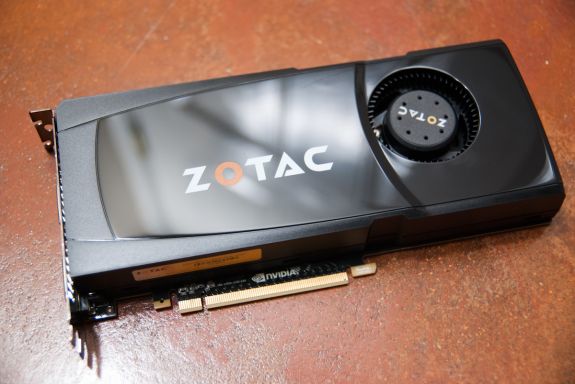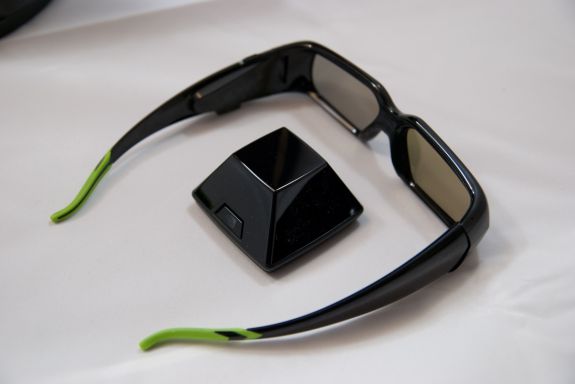ASUS VG236H 23-inch 3D Display Review: 120Hz is the Future
by Brian Klug on August 7, 2010 2:48 AM EST3D Vision on the VG236H
So let’s talk about 3D for a bit before going into the deep bits of the display’s performance. We’ve already covered NVIDIA’s 3D Vision here, but this review would just be incomplete without discussing how much I’ve changed my mind about 3D after playing with the VG236H.
First off, the NVIDIA 3D Vision kit itself is unchanged, though the packaging is a bit more compact. Inside is a soft cloth bag for the classes, two different nasal guides for comfort, two different length USB cables, the IR base station pyramid, shutter glasses, and demo and driver CDs. It feels like a high end product, with the base station pyramid and glasses sitting in foam cutouts, and the requisite accessories in a compartment above.
Additionally, you’ll need a 3D Vision compatible GPU, and can only drive 120Hz refresh rates over DVI-D, not HDMI. Because you’re rendering twice the frames (one for each eye), you’ll take a framerate hit for enabling 3D, so that GPU best be powerful. Zotac graciously supplied their ZOTAC GeForce GTX 470 for testing, which worked perfectly in my testbench.
I noted before that I’ve been skeptical about mainstream 3D gaming for some time now. I’ve seen my fair share of 3D content - though not as much as most of the other AnandTech writers that experienced it at CES on myriad displays - but have an above average grasp for the tech thanks to my optical sciences background.
That out of the way, most of the shutter or polarization based methods I’ve seen up until now suffered from being flickery. Refresh rate just wasn’t high enough, and the result was that I could detect individual frames when moving my head or really looking for it. In theaters, I tried the circularly polarized passive RealD system, and another IMAX 3D system using linear polarization. I had also tried a number of active LCD shutter systems on LCD TVs. While impressive, all of them had noticeable flicker.
The VG236H is the first 3D implementation I’ve played with that doesn’t have noticeable flicker. It just doesn’t. I was immediately impressed with the NVIDIA 3D Vision setup.
NVIDIA thankfully has a pretty comprehensive list of 3D Vision games and how good they perform with the whole system. At the top of the scale is 3D Vision Ready, meaning the game has basically been developed from the start to be viewed in 3D or 2D. Down the list is excellent, good, fair, poor, and not recommended. I first tried a number of ‘good’ titles, and found that while the 3D experience indeed worked, but often small things got in the way.













121 Comments
View All Comments
user72 - Saturday, August 7, 2010 - link
I have some molecular modeling programs that use OpenGL QuadBuffer for 3D rendering. Do you know if this monitor is compatible with QuadBuffer? Thanks!Sp12 - Saturday, August 7, 2010 - link
Until I can get 120hz IPS technology I'm unimpressed. 120hz is in no way worth it for the dithering and inconsistent colors TN brings. Especially if it comes at a premium like that.I may be waiting forever until blue phase or autostereoscopic displays come around.
http://en.wikipedia.org/wiki/Blue_Phase_Mode_LCD
http://en.wikipedia.org/wiki/Autostereoscopy
Soldier1969 - Saturday, August 7, 2010 - link
1080 monitors suck after having 1920 x 1200 since Jan of 2007 I will never go backwards in resolution. When they make a 2560 x 1600 LED backlit 120hz panel I'll get one but these 1080 ones cater to the poor folk.Daeros - Saturday, August 7, 2010 - link
This review just highlights why I still use a pair of HP 1230 21" crt monitors. Sure, they weigh about 70lbs each, but they are like 6 years old and have no problem running at 2048x1536 @ 110Hz . Show me any lcd that can do that. And don't even get me started on gamut or black levels.Zok - Saturday, August 7, 2010 - link
Well, without getting into the old CRT-LCD argument too heavily, my desk can't handle a 30" CRT - size or weight.DarkUltra - Sunday, August 8, 2010 - link
1536x110hz = 169Khz horizontal frequency. That is amazing.. I thoght my lacie electronblue22 III was good at 1440x85hz :)Luke212 - Sunday, August 22, 2010 - link
yeah its a nice story but his crt can only do 91hz at that rez.(140k/1536)
adonn78 - Saturday, August 7, 2010 - link
I think its over priced for a 23 inch monitor. I'd rather get a larger screen than one with features I'll never use such as 3D.DarkUltra - Sunday, August 8, 2010 - link
It's not just the 3D. 120hz give you a much smoother Windows experience, and the lack of RTC artifacts is also good.SunLord - Monday, August 9, 2010 - link
Any monitor over $300 isn't worth buying even fi its 120hz and the newest gimmick to get stupid people to pay more